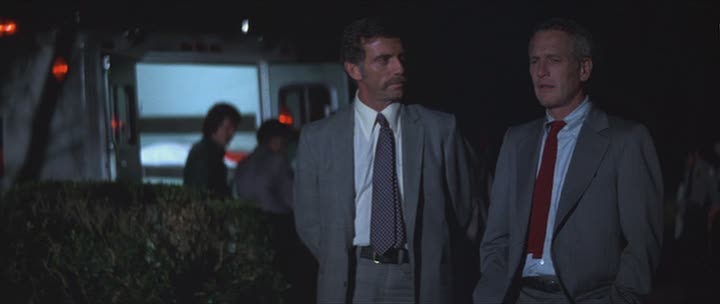Lost And Found Series: Chapter 8 Keep Head Above Water

Welcome back! Did everybody enjoy their gritty sarcastic time with Elliot Gould and Robert Blake in the last chapter with Busting? I should hope so. This week we are again moving on to something different but still similar by delving straight into arguably my favourite character in cinema…the private detective. There is nothing better than watching someone in a slick suit, with a pack of cigarettes driving a busted car get themselves into a murky situation where nobody can be trusted and they are in the middle of it all, like us, trying to work everything while coming across inept henchmen and peculiar clues. Paul Newman has the pleasure of do experiencing most of these things in…The Drowning Pool.
Film: The Drowning Pool
Cast: Paul Newman, Joanne Woodward, Murray Hamilton and Melanie Griffith
Director: Stuart Rosenberg
Writers: Tracy Kennan Wynn, Lorenzo Semple Jr., Walter Hill, Ross Macdonald and Eric Roth
First some background knowlegde on the sort of film we will be dealing with in this chapter. The earliest cinematic film noir conventions were found in the works of American detective fiction writer Raymond Chandler, in film adaptations of his novels introducing the world to his protagonist Philip Marlowe, the on-screen archetype private detective. Since then the film noir/private investigator aspect in film is quite a tricky one as many would argue that it is more of a style used in film as opposed to a definite genre such as horror or comedy. This is mainly due to the fact that the attributes can be incorporated into any type of film, as most of the traits are easily recognisable, rather than compulsory, to the plot across a spectrum of genres. Ultimately the films are very engaging, and one can enjoy different takes on the workings of a film noir due to the individual style of the director that takes on such a project. Exploring the dark world of private detectives usually included chiaroscuro lighting, smoky interiors, distressed wives and convoluted plots. As quite a nostalgic and reflective person, one tends to be intrigued by most of these films that include these conventions. In the sixties and seventies the audience started to see the birth of the neo-noir, a modern take on the style that took the traditional conventions and updated them.
After watching Harper (released as The Moving Target in the UK) some years ago, I liked the film but not as much as I had hoped. Heralded by many as a great detective film and starring one my favourite actors Paul Newman, what could go wrong. Well nothing really but everything that went right seemed rather bland. However, the rarely spoken of sequel The Drowning Pool was included in the same Paul Newman box set so I did some research on it.
A direct sequel to Harper called The Chill was planned but fell through. Instead another novel by the same author Ross Macdonald was adapted by then unknown screenwriter Walter Hill who would go on to direct classics including The Warriors and The Driver (a film you fans of recent cult hit Drive should seek out as there are many similarities). Although there is limited information about how this picture was made, going by the reactions and amount of screenwriters that lent their hand to the script, one could probably conclude that it had its fair share of shooting conflicts and studio interference.
The film credits include five, yes five, writers one of which being Eric Roth of Forest Gump fame. Also Newman came very close to having a major accident off set while racing a Porsche car at a race-track and resulting in him nearly losing his fingers. This film seemed to be plagued with problems but luckily survived all the chaos.
Lew Harper’s (Paul Newman) private detective services are called upon by an old flame Iris Devereaux (Joanne Woodward) to investigate a blackmail scheme involving herself and troublesome daughter Schuyler (Melanie Griffith). Harper agrees to help. The trouble soon begins as he gets tangled up in a power dispute between Devereaux’s cold-hearted mother-in-law and ruthless oil baron Kilbourne (Murray Hamilton) who will stop at nothing to acquire all the land he wants in Louisiana. Harper becomes a target to everybody including the local police while trying to make sense of everything.
As a fan of Newman, one would declare The Drowning Pool as one of his most undervalued performances. Its puzzling to think why Lew Harper is one of his least celebrated roles which. Although it is rumoured Newman did not enjoy shooting the picture, he did admire playing a character like Lew Harper. He felt as though there were no artistic boundaries in his approach and could do as he wished with Harper. Described by Ross Macdonald in the short documentary ‘Harper Days Are Here Again’ (I know), ‘Harper is a simplified version of Paul Newman’. There is a conscious yet brash awareness to Harper, influenced by Philip Marlowe, his cynical take on the world and the people that run it are balanced with his charming sense of humour and nonchalant charisma that remains strong no matter how much pressure he is under.
Most of the people around Harper cannot deal with his almost existential outlook and react with either violence, intimidation, allured by his individual charm or attempt to bribe him. The hoodlums sent to either kill or scare Harper usually end up assaulting him when he responds to their violent advances with candid dry humour. Others try to persuade him with money order to stay away but he would rather risk everything and get to the root of the problem of the case.
The rest of the cast shines too. Standout performances include a young Melanie Griffith making things more complicated due to her unusual hatred for her family. Murray Hamilton is sadistic and scary as greedy entrepreneur Kilbourne who comes up with an awful way to get information out of his wife and Harper by putting them into an abandoned asylum hydrotherapy room and spraying them with an onslaught of water. This leads to a magnificent scene where Harper comes up with an idea for him and Kilbourne’s wife to escape. Things do not go as planned and what follows is one of the most intense, claustrophobic climatic scenes ever filmed…and here it is.
Rosenberg’s direct, mellow direction compliments the events taking place on-screen and adopts a straightforward approach as opposed to flashy visuals that may distract viewers from the complex storyline that demands your full attention. The cool Jazz score by Michael Small is a real treat too and heightens any sense of unsettling danger or relief that Harper regularly gets himself into and out of. This is a film worth your time. It deserves to be mentioned along with the other great private detective films of the seventies such as Arthur Penn’s bitter gem Night Moves and Robert Altman’s revisionist masterpiece The Long Goodbye. If only they still made them like this today.
You can watch the whole film on YouTube. Here it is.


















Must Reads
David Holmes – Humanity As An Act Of Resistance in three chapters
As a nation, the Irish have always had a profound relationship with the people of Palestine
Rotterdam – A City which Bounces Back
The Dutch city is in a state of constant revival
Going Remote.
Home swapping as a lifestyle choice
Trending track
Vels d’Èter
Glass Isle
Shop NowDreaming
Timothy Clerkin
Shop Now